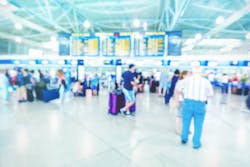Like with any horrific shooting or bombing attack, the aftermath is wrought with the inevitable finger pointing, arm-chair quarterbacking, and incredulity about how this could happen here? Unfortunately, the scenario was no different last week following the senseless shooting deaths of five passengers in the baggage claim area of the Ft. Lauderdale airport.
The mass shooting on January 6 occurred in the proximity of baggage claim in Terminal 2, which is shared by both Delta and Air Canada Airlines. While the shooting lasted just over a minute, it seems the plot to carry it out was well planned, as the shooter brought a checked 9 mm pistol onto the airplane from his origination point in Anchorage, Alaska with the intent of carrying out the carnage in Florida. Immediately after retrieving his pistol from his checked bag, the shooter calmly strolled through the claims area firing at random until he ran out of ammunition. Once his weapon was empty he simply laid down on the floor and surrendered.
However, as stunning and gut-wrenching as the Ft. Lauderdale airport shooting was, it is good to put context to it in the big picture of airport security. Within the last 35 years, there have been 25 airport terrorist attacks and/or shootings at international airports outside the United States. Previous to last week’s Ft. Lauderdale attack, there had only been three fatal encounters at a U.S. airport.
The most deadly airport attack in America was on December 29, 1975, at LaGuardia Airport. A bomb blast in the TWA baggage terminal killed 11 and seriously wounded 74. While the bombing was never solved, investigators believe that Croatian nationalists were likely behind the attack.
The check-in counters at the Tom Bradley Terminal of Los Angeles International airport was where the other shooting incident occurred on July 4, 2002. A lone gunman armed with two pistols opened fire on passengers checking in for an El Al flight to Israel. The Egyptian national assailant shot and killed a ticket agent at point blank range and a 46-year old Israeli who was huddled with other passengers near the counter. The shooting of a TSA agent at LAX in 2013 was the last fatality at a U.S. airport.
Many airport security professionals agree that when you begin assessing the safety of America’s airports, it is important to avoid the obvious knee-jerk reactions that follow any tragedy. Keeping threats in perspective is crucial.
In a blog posted on his Leading Edge Strategies website this week, Jeffrey Price, airport security expert and author of several aviation security textbooks wrote: “In the wake of the Ft. Lauderdale active shooter attack, three ‘solutions’ are beginning to emerge. Unfortunately, many of these solutions will provide the public a sense of safety, and politicians will appear to be doing ‘something’, but the measures could cost a lot of money and the only return on the investment is that flying becomes more difficult, and possibly, makes air travel even less safe. Plus, money spent on largely useless measures is money that could be better spent doing actions that actually increase the protection of the public areas.”
After reading the Price blog it was clear he was saying there are no quick fixes in dealing with such complex issues as securing public spaces. So I contacted Jeff to follow up on some of the issues brought to light in the Ft. Lauderdale shooting.
The baggage and ticketing areas of U.S. airports are like malls, they are open and welcoming spaces. Price admits protecting spaces like these present a huge challenge to airport security personnel.
“The protection of public spaces is one of the most difficult responsibilities for security and law enforcement personnel due to the inherent ability of anyone to enter the area. However, there are tactics that can be used and are used in other contexts, to increase the security of a particular public area, and to reduce the likelihood of an attack on the public. Just as most criminals don’t want to commit a crime with a police officer present; most attackers do not want to immediately engage with armed law enforcement. Most often, an attacker, whether an active shooter or bomber, desires to evade detection prior to the attack, and once the attack has begun, wants to attack as many people as possible until the police show up,” says Price. “As we saw with the recent attack, most airports immediately increased police patrols of their public areas, primarily ticketing and baggage claim areas. The ‘surge’ in patrols is common in response to an attack just in case there were other attacks planned at other facilities.”
Price went on to say that until more information is available, airport operators don’t know if the Ft. Lauderdale shooter had collaborated with five other suspects on the Internet to carry out multiple attacks at multiple locations, similar to the Mumbai active shooter attacks.
“Also, the act itself may immediately inspire copycat attacks. But, after time, airports will usually roll back from their higher levels once it’s perceived that the threat has gone away - until the next time,” he warns.
According to Price, the protection of public areas typically includes a visible presence of law enforcement and security personnel, and some CCTV coverage and panic button type alarm systems. Additional levels can include plain-clothes personnel, behavior detection training for security personnel and employees that work in the area, random screening, and random security sweeps by security and police personnel (similar to the TSA’s VIPR program or NYPD’s Hercules teams).
As for as transporting a weapon on the flight, it appears the shooter followed normal gun shipping protocols as he transported his weapon from Alaska to Ft. Lauderdale. Even if harsher rules were applied to shipping weapons, Price knows there is always an alternative to skirt regulations.
“From what I know so far, there doesn’t appear to be a breakdown of the system. I can’t find anywhere in the regulations where it says the weapon must be claimed at the baggage office instead of the carousel, but that is a standard airline procedure. Mostly, though, claiming it in the office is to prevent the theft of the weapon, which may stand out if it’s on the baggage carousel,” Price points outs. “I don’t think prohibiting the ability to carry a weapon in checked baggage will prevent future attacks. The next attacker can simply ship it to himself at a nearby FedEx store, fly to the airport, Uber or taxi over to the store and come right back. In this case, the ability to have the gun there just saved him time and money.”
According to Price, politicians are beginning to suggest proposals like relocating screening checkpoints to the curb; a push to revise the regulations restricting individuals from checking guns on board the airplane, and somehow trying to get TSA screeners more involved in the protection of the public areas.
But when you look at the terrorist attack at the Ataturk airport In Turkey last year, even though passengers must pass through metal detectors and have their bags scanned before entering the departure terminal, these measures failed to stop the bombers. Price realizes more enhanced technology can provide enhanced deterrents, but who pays for it?
TSA has previously deployed technology to scan crowds en masse. The original deployment was used at Denver International Airport during the Democratic National Convention in 2008. There are other similar technologies to detect items such as bombs, or even some cases to detect ill-intent.
“The big question, however, is whether the risk is worth the cost. I get that ‘if it saves just one life it’s worth it,’ argument but airport operators have to prioritize safety and security projects and costs all the time. If one piece of technology makes it safer to land at the airport, while another reduces the chances of an active shooter, but there’s a higher probability of an aircraft accident (and often the security probability is unknown), then the money goes to the safety project,” admits Price.
So then should airports increase their manned security presence?
“I think we should increase law enforcement at airports but without a government mandate, it won’t happen. You have some airports like LAX that have extensive police coverage, uniformed and plain-clothed, plus special gang units, narcotics units, etc., but that’s because that airport has seen a higher number of attacks and attempted attacks, whereas other airports struggle to pay for the minimum number of police they need to meet the TSA requirements,” Price says. “I’m not advocating we expand TSA’s mission and start arming their personnel, but I would advocate for a federal grant program to help airports provide higher levels of police coverage.”
But for Price, the security weakness at most of the country’s airports in not the lack of technology or security personnel, it’s the lack of training and exercises that airport police, fire, EMS and other personnel are required to do.
“A key method of protecting a public area, particularly one in which attacks and incidents are rare, is keeping sharp through frequent training, exercises, and drills. Otherwise, your personnel gets complacent and when nothing has happened for a while, they expect nothing to happen - so when it does, they’re not ready for it. The requirements for airports to conduct both aircraft accident drills (every 3 years), and security drills (a tabletop exercise once a year), are ridiculously low,” Price admits. “This is where we take a lesson from the Israelis - their security personnel is tested daily in some way shape or form. In my textbook on Airport Operations, Safety and Emergency Management, I highlighted Denver International Airport which has adopted this model for their fire/rescue personnel and conducts dozens of tabletops, live drills, and exercises every month! That’s a model that needs to be copied.
“Beyond that, most of the 9/11 legislation (and subsequent legislation) addressed the protection of the aircraft, not the airport, which was appropriate given those are the areas that needed the most protection at the time. But few areas of legislation, beyond the requirements to receive airport identification credentials, addressed airport security. We still don’t have a requirement for airport ID badge systems to incorporate biometrics, we don’t require perimeter intrusion detection systems at our busiest and highest-risk airports (or any airport for that matter), and we don’t require any police coverage or security requirements for the protection of people in the public areas of an airport,” concludes Price.
About the Author:
Steve Lasky is the editorial and conference director for SouthComm Security Media and a 30-year veteran of the security industry.
About the Author
Steve Lasky
Editorial Director, Editor-in-Chief/Security Technology Executive
Steve Lasky is Editorial Director of the Endeavor Business Media Security Group, which includes SecurityInfoWatch.com, as well as Security Business, Security Technology Executive, and Locksmith Ledger magazines. He is also the host of the SecurityDNA podcast series. Reach him at [email protected].

